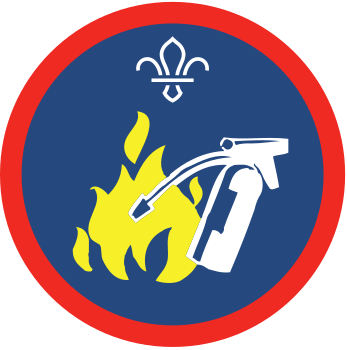Fuel, air, ignition!

Learn what to do
- Everyone should gather in a circle.
- The person leading the game should ask if anyone knows what three things fire needs. It needs heat, oxygen, and fuel – this is sometimes called the fire triangle. To put out a fire, you need to remove at least one of the three parts of the triangle.
- Everyone should think about what they’d do if someone’s clothes were on fire. They could use a water fire extinguisher (or pour a bucket of water over them), but one of the best things to do is to ‘stop, drop, and roll’. This doesn’t need any equipment, but it stops oxygen getting to the fire.
- The person leading the game should explain the three steps: stop (whatever you’re doing, and carefully put down anything you’re holding), drop (get down on the ground), and roll (roll back and forth to stop oxygen getting to the fire).
- Everyone should remember that fires can produce lots of smoke that can make it difficult to breathe. If a room’s filled with smoke, the best thing to do is get low to the ground as both smoke and heat travel upwards.
Test triangles
- The person leading the game explains the hand signals: fuel (make a flat palm, like paper in ‘rock, paper, scissors’), heat (make a fist with your hand and flick your thumb upwards as though you were lighting a lighter), oxygen (make an ‘o’ shape with your hand, arching your finger and thumb).
- Everyone should move around the space.
- When the person leading the game calls out ‘smoke’, everyone should get low to the ground as if they were avoiding smoke and keep crawling or moving along while squatting.
- When the person leading the game calls out ‘sparks’, everyone should get into groups of three.
- Each group should count to three. When they say three, everyone should make one of the hand signals from step one and call out the name of the sign they’re making (fuel, heat, or oxygen).
- If the group has at least one of each of the symbols (fuel, heat, and oxygen), they’ve made a fire. They should stop, drop, and roll – making sure they don’t roll into anyone else of any obstacles in the room.
- Everyone should get up and carry on moving around the room, waiting for the person leading the game to call ‘sparks’ or ‘smoke’ again.
Reflection
This activity was all about developing skills. Now, everyone understands how fires happen and how they could deal with a clothes fire in an emergency. Why was it useful to understand the fire triangle? Knowing what fires need to keep burning helps us understand what we can do to make them stop. Why is stop, drop, and roll such a useful thing to know? It’s quick and doesn’t need any equipment. What could people do if they can’t drop and roll? Others could help them use a fire blanket, a large wet cloth or a damp towel.
Safety
All activities must be safely managed. You must complete a thorough risk assessment and take appropriate steps to reduce risk. Use the safety checklist to help you plan and risk assess your activity. Always get approval for the activity, and have suitable supervision and an InTouch process.
- Active games
The game area should be free of hazards. Explain the rules of the game clearly and have a clear way to communicate that the game must stop when needed. Take a look at our guidance on running active games safely.
Depending on the number of people in your group, change up how many people should be in the ‘sparks’ groups. The bigger the groups, the more likely it is that there’ll be a successful fire.
Being in a real fire can be traumatic. Before you start this activity, think about if anyone’s ever experienced a real fire – you may want to give people the chance to let you know if they’re not comfortable taking part (or if you need to avoid a particular scenario, or make other adjustments such as having a safe space to retreat to). Everyone should know that they can stop at any time if they don’t want to carry on.
This activity’s about learning the skills to be safe in the unlikely event of a fire. People should leave feeling empowered and confident, not anxious or scared. Make sure you have time to chat at the end.
All Scout activities should be inclusive and accessible.
Learn more about what sorts of materials are more flammable than others. Check your clothes labels – are your clothes high risk?
